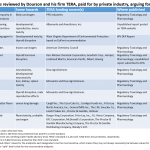Proof in pudding: EPA toxics nominee Dourson has consistently recommended “safe” levels for chemicals that would weaken health protections
Richard Denison, Ph.D., is a Lead Senior Scientist.
[Use this link to see all of our posts on Dourson.]
Earlier this week the New York Times ran an article on the Trump Administration’s nominee to run the EPA toxics office, Michael Dourson. The article detailed Dourson’s longstanding ties to the chemical industry, citing examples of work he did on specific chemicals paid for by the companies that make or use them.
What is remarkable about Dourson’s work in light of his nomination is not just his conflicts, but the fact that his paid work consistently has led to him recommend “safe” levels of his clients’ chemicals that were less health-protective than government standards or guidelines prevailing at the time. The Times article referred to an analysis by EDF in discussing the example of the pesticide chlorpyrifos. Chlorpyrifos is one of 10 chemicals included in EDF’s analysis, which is provided in this post.
EDF first reviewed papers and reports that Dourson or other employees of his company, Toxicology Excellence for Risk Assessment (TERA), co-authored that focused on specific chemicals and that disclosed the work was paid for by companies or trade associations with a vested financial interest in those chemicals. (The one exception is PFOA, where Dourson was hired by the state of West Virginia based on the recommendation of its producer, DuPont.)
We then focused on the subset of those papers or reports that argued for a specific numeric “risk value” or release or exposure limit for the chemical in question. That left us with 10 such chemicals.
Finally, we compared Dourson’s recommended value for a chemical with existing standards or guidelines issued by federal or state government agencies or, in their absence in two cases, by the American Conference of Governmental Industrial Hygienists (ACGIH). [Note: Because what matters most regarding the “safe” level of a chemical is that for the most sensitive endpoint, our comparisons are generally between the values for endpoints that Dourson and others designate to be the most sensitive. The values being compared, therefore, may not always be for the same endpoint, or derived from the same type of risk value.]
The table here (click to enlarge) summarizes the results of our analysis. It shows who funded Dourson’s work on each chemical. Details of the analysis with links to relevant sources are available here.
Several features of this analysis bear mention:
- For all 10 chemicals, Dourson’s recommended “safe” level was less health-protective than the prevailing standard(s) at the time of his work, often dozens or even thousands of times less health-protective – see the right-hand column of the table.
- For several chemicals, government standards have tightened significantly since Dourson’s work, making his standard even less health-protective based on more recent information. (Our table includes comparisons of Dourson’s values to newer standards for 1-bromopropane, PFOA and chlorpyrifos.)
- Three of the chemicals are among the first 10 chemicals EPA is now reviewing under the recently reformed Toxic Substances Control Act (TSCA). If confirmed, Dourson would immediately be overseeing these reviews.
- Finally, in every case where Dourson or TERA published a paper of their results, that paper was published in Regulatory Toxicology and Pharmacology. I have blogged previously about the large fraction of Dourson’s papers published in this one journal, which has extensive ties to both the tobacco and chemical industries.
Recently The Intercept uncovered an internal industry memo revealing that chemical company employees regarded Dourson and his firm TERA as the place to go when they wanted to develop a new “safe” level for their chemical and then work to “sell” it to EPA or other agencies.
The proof is in the pudding: Dourson has deployed a consistent modus operandi, which as our analysis presented here shows, has led him to consistently recommend chemical safety standards that would weaken our health protections. He’s the last person to be running EPA’s chemical safety program.
Current EPA political appointees already include a number of industry insiders.
Click here to see brief thumbnails on individuals who have already been installed.













